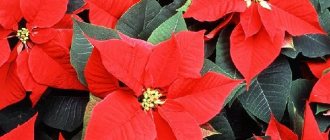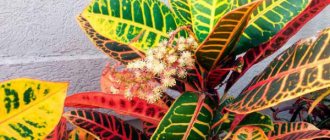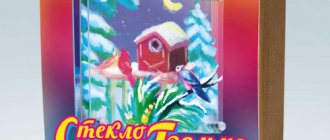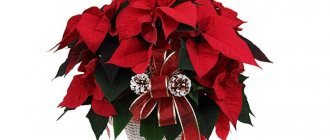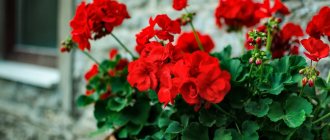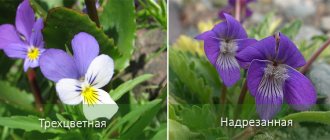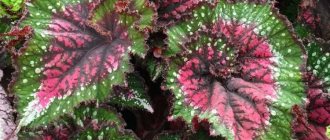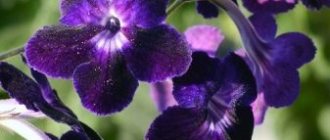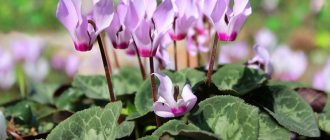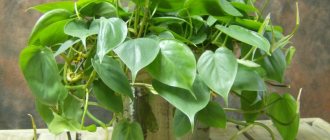These plants are native to Central America and in the wild they live in the highlands along the Pacific coast. The Christmas star was first described in 1834 by the German scientist Johann Klosch (1), who also gave it a Latin name in honor of the botanist Joel Poinsett, who was the first American ambassador to Mexico. But in Russian botanical literature this flower has a more prosaic name - beautiful spurge (Euphorbia pulcherrima). Yes, yes, poinsettia belongs to the genus Euphorbia and is a member of the Euphorbiaceae family.
In nature, poinsettias reach a height of 3 m, but in cultivation they are much more modest, and modern varieties are completely short - no higher than 30 cm. They bloom from December to February, the peak of their decorative value falls on the main winter holidays - hence the name “Christmas star” . In Europe and America, this flower is a symbol of Christmas, and every year on the eve of the holiday, about 60 million poinsettias in pots are sold around the world. By the way, the main supplier of these plants is not Holland, as many people think, but the USA - they provide 50% of the world market.
The most interesting thing is that poinsettias are sold only at the moment of flowering, but the flowers themselves are of no interest - they are small and inconspicuous. But the plant came up with a trick - when the buds appear, the upper leaf bracts turn bright red, which attracts pollinating insects. It is these leaves that give the Christmas star its unique appearance.
Varieties of Christmas star flower
There are not so many varieties of the Christmas star, but their number is growing from year to year. They differ mainly in the color of the upper leaves. The very first, Red Star , was released in 1919 (2). And now the most popular varieties are:
- Carousel Pink - with soft pink bracts, which have green veins;
- Da Vinci - delicate pinkish variety with red splashes;
- Jester Red - it has bright red leaves with dark veins;
- Jingle Bells - with red upper leaves, on which there are white inclusions, similar to snow flakes;
- Marble – with cream bracts and a pink-red heart-shaped inflorescence (3);
- Premium Miro – with white and pink bracts;
- Premium Red - a classic variety with red leaves at the top;
- Strawberry and cream - a very unusual variety with pink-purple leaves with a heavily cut white edge;
- Winter Rose White - with white bracts that are slightly compressed and resemble rosebuds.
Variety Carousel Pink. Photo: wikipedia.org
Variety Jingle Bells. Photo: wikipedia.org
Da Vinci variety. Photo: wikipedia.org
Variety Jester Red. Photo: wikipedia.org
Premium Miro variety. Photo: wikipedia.org
Caring for a Christmas star flower at home
You probably see these luxurious flowers at your friends’ houses during the New Year holidays. However, you won’t find them on windowsills in spring or summer. Why? Yes, because poinsettias are very whimsical plants. There is an art to pleasing them! Not even every greenhouse undertakes to add them to its collection. By the way, in America and Europe, the Christmas star is considered a disposable plant: they treat it the same way as bouquets - admired during the holidays and thrown away.
But if you still decide to fight until victory, then take into account all the whims of this flower.
Important! Christmas star juice is poisonous! If it is accidentally licked by an animal or child, it can cause poisoning - vomiting, diarrhea, serious irritation of the gastrointestinal tract and even contact dermatitis. Therefore, you only need to replant and propagate the plant while wearing gloves. The flower can also cause allergies in people who react to plant pollen.
Priming
Poinsettia loves slightly acidic soil (pH – 6 – 6.5) so you need to add high-moor peat to the soil composition. There are 2 options for soil mixtures (2) that are used to grow a Christmas star:
- peat or compost, leaf soil, turf soil, crushed pine bark and sand in a ratio of 1:1:1:1:1;
- peat, turf soil, humus and sand in a ratio of 1:1:1:1.
Temperature
The Christmas star does not like cold or heat; it needs a temperature no higher than 20 °C. During the flowering period it should not fall below 17 °C. During the dormant period, which, unlike other flowers, for poinsettias occurs from March to October, you can put them in a cool, shaded place where the temperature will not be lower than 12 °C.
Poinsettia does not tolerate drafts and sudden temperature fluctuations, so when ventilating, always remove the flower from the windowsill.
Lighting
The Christmas star loves plenty of sun during the flowering period. And this is the main problem, because from December to February in the middle zone there are the shortest days and the plant is sorely lacking in light. Therefore, if you are going to preserve the plant, you will have to supplement it with phytolamps - they should be turned on for 8 - 9 hours a day. But in summer, poinsettias, on the contrary, need to be shaded from the scorching sun (3).
For poinsettia to bloom, it is important that there is no more than 8 hours of daylight - if it is 12 hours, the buds will not form and beautiful colored leaves will not appear.
Humidity
In winter, poinsettias need to be watered frequently, about 2 - 3 times a week, but it is important not to overwater - the flower does not like excess moisture. The top layer of soil should dry out slightly between waterings. In the summer, when it’s hot, you need to water it abundantly, because peat-based soil dries out very quickly.
Poinsettia leaves need constant moisture. Photo: wikipedia.org
The water must be warm, at least room temperature, and certainly not from the tap. Water the poinsettia at the root. But the leaves also need constant moisture, otherwise they may lose color. Therefore, you need to spray the flower often, especially in winter.
Fertilizers and fertilizers
The vast majority of indoor plants are fed from March to September, but for poinsettia the opposite is true - its active period and flowering period is in the winter, so it needs to be fertilized from November to March every 2 weeks. Any liquid complex fertilizer will do.
In summer, during the dormant period, fertilizers are also needed, but they are given rarely - about once every 1.5 months.
Trimming
In March, poinsettia usually fades and a dormant period begins - at this time the flower must be cut by about 1/3, leaving 10 centimeters above the ground. After pruning, the plant should be placed in the shade and not watered until May (3).
At the beginning of May, the Christmas star should be transplanted into a new pot and watered thoroughly. When new shoots appear, you need to leave 4 - 5 of the strongest ones and cut out the rest.
Irezine - a home flower with red-green leaves (with photo)
Irezine
Not only is it a very unassuming flower with red and green leaves, but it is also a cheerful splash of fiery red among other species. Within a year, the young plant forms a dense bush about 30 cm high with soft stems and red leaves. The following types of home flower with red-green leaves are most often on sale: Herbst's iresine (Iresine herbstii) and Linden's iresine (Iresine lindenii).
Look at the flower with red-green leaves in the photo, where the crop is shown in a variety of floral compositions:
Family: Amaranthaceae (Amaranthaceae).
Homeland: South America.
Location: As bright as possible. With a lack of light, the brightness of colors is lost.
Temperature: Room temperature is preferable, not lower than 15 °C.
Air humidity: Does not tolerate too dry air.
Substrate: Flower soil mixture.
Watering: Just maintain moisture.
Feeding: Every week in summer, once every 6 weeks in winter.
Replanting: Every year young plants develop intensively, old ones become unsightly.
Pruning: Trim the tops of young trees more often to encourage bushier growth.
Reproduction: Cuttings in water.
Pests, diseases: Rare.
Neoregelia
Narrow sword-shaped leaves form a flat rosette. During flowering, the leaf color of most species clearly changes: in some the tips of the leaves become bright red (Neoregelia spectabilis), in others the leaves in the center of the rosette turn red (Neoregelia carolinae). The unusual beautiful color lasts for months. Plants are hung on trunks and cultivated as epiphytes.
Family: Bromeliaceae (Bromeliaceae).
Neoregelia's homeland: Brazil.
Location: Bright, some sun.
Temperature: Room temperature, in winter also not lower than 18 °C.
Air humidity: Quite high. Do not spray, provide artificial humidity.
Substrate: Low-fertility, peat with styrene chips, as for epiphytes.
Watering: Use soft water in a funnel, the substrate is moist.
Feeding: Every 2 weeks with half the concentration, also in a funnel.
Replantation: Not required.
Reproduction: Offspring.
Pests, diseases: Rare.
Important! Every 2 weeks, drain the old water from the funnel and add new water.
Reproduction of Christmas star flower at home
Poinsettia is propagated by apical cuttings - the shoots that remain after pruning in May are suitable. However, rooting them is not so easy.
Cuttings are cut with 4 - 5 leaves. The bottom ones are removed, leaving only the top 2. After this, they are placed in warm (30 - 40 ° C) water for 30 minutes so that the milky juice comes out of them. After this, the cuttings are dusted with a root formation stimulator (Heterauxin or Kornevin) and planted in pots in loose, moisture-absorbing soil. The ideal option for rooting is a mixture of peat and sand in a 1:1 ratio (2).
The cuttings are buried 1.5 - 2 cm into the soil, no more - when planted deep they begin to rot. Pots with cuttings should be kept in a warm room (20 - 25 ° C) with moderate lighting. It is also important that the soil temperature is about 20 °C, so do not place the pots on the windowsill if there is blowing air from the window.
After 10 - 15 days, callus forms on the poinsettia cuttings, on the 20th day roots appear, and after 25 - 30 days the cuttings are completely rooted (2) and can be transplanted into larger hills.
There are not many varieties of the Christmas star. Photo: wikipedia.org
Basic requirements of Guzmania - light, temperature, humidity
Even such an unpretentious home flower as Guzmania requires compliance with certain conditions.
Many amateur aquarists breed angelfish at home; it is not difficult. How many people know what this name of popular aquarium fish means?
Look right now how beautiful and unusual the ordinary garden lilac is!
So, it is placed on western or eastern windows, in partial shade . Guzmania can only be moved to the south side in winter - this compensates for the natural lack of light.
Important! There is no need to place this delicate epiphyte on the windowsill. During the heating season it will die due to low humidity, and in summer direct sunlight will cause severe burns.
As for the temperature , even novice gardeners will not have problems here: in summer 20-25 degrees is enough, and in winter - no lower than 17. If the temperature drops to 16 degrees, the plant may get sick or not want to bloom.
The Morente look seems to imitate the colors of autumn.
to humidity , because it comes from the tropics. In summer, take it out onto the loggia, and in winter, a lighted bathroom may be a suitable place. You can place a humidifier or indoor fountain nearby. Regularly add water to the pan, but do not let it stagnate. Guzmania will also like spraying - and in the heat, “showers” can be carried out 2 times a day.
Lemon guzmania with bright yellow bracts.
Diseases of the Christmas star flower
Poinsettia problems are most often associated with improper care.
The edges of the leaves turn yellow and dry. The reason is dry air.
Poinsettia needs to be sprayed frequently, then there will be no problem.
The leaves are withering. There may be opposite reasons - insufficient watering or, conversely, excessive soil moisture, especially if the plant is on a cold windowsill.
Following the watering regime will help solve the problem.
Rules for watering and fertilizing
Caring for Guzmania at home means maintaining an optimal microclimate and proper watering. The main recommendations here are:
- a small amount of water is poured directly into the outlet, and the remaining water is removed after a few minutes;
- water the soil rarely - only if it is very dry;
- In winter, 1-2 waterings per week are sufficient, and in summer, daily watering is required;
- overwatering is more dangerous for Guzmania than overdrying;
- For spraying, use only clean water, and to remove dust, the leaves are occasionally wiped with a cotton swab.
The magnificent Donella-Smith.
When Guzmania blooms, it needs mineral supplements . It is worth buying a special complex for bromeliads that dissolves in water. Fertilizers in the form of a solution are also applied to the outlet. The frequency of feeding is once a month.
Interesting! If Guzmania is in favorable conditions, but does not bloom, then place apple slices in a bag on the ground (just make sure that they do not become moldy over time). The fruit will release ethylene and the plant will bloom very quickly.
Pests of the Christmas star flower
Poinsettia is susceptible to attacks by pests and it is important to detect them in time so that the plant does not die.
Spider mite. With a small infection, it can be recognized by numerous whitish spots on the leaves. If there are a lot of pests, the leaves turn yellow and fall off, and the plants become covered with cobwebs.
You can get rid of spider mites using the drug Kleschevit (4).
Mealybug. The main signs of this pest are white lumps on the leaves, similar to cotton wool, and sticky honeydew.
To combat this pest, the drugs Fitoverm or Actellik are used (4).
Thrips. Signs of damage can be found on the leaves - they become covered with oblong spots and curl.
The drug Aktara will help in the fight against thrips (4).
